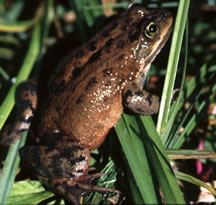Oregon spotted frog
| Oregon spotted frog | |
|---|---|
 |
|
| Scientific classification | |
| Kingdom: | Animalia |
| Phylum: | Chordata |
| Class: | Amphibia |
| Order: | Anura |
| Family: | Ranidae |
| Genus: | Rana |
| Species: | R. pretiosa |
| Binomial name | |
|
Rana pretiosa Baird & Girard, 1853 |
|
 |
|
| Oregon Spotted Frog range | |
The Oregon spotted frog (Rana pretiosa, meaning "precious frog") is a member of the frog family Ranidae of order Anura. It is a medium-sized aquatic frog endemic to the Pacific Northwest and historically well distributed in the Puget Trough/Willamette Valley province and the Cascade Mountains of south-central Washington and Oregon. It is relatively rare within its range and is listed globally as vulnerable.
Oregon spotted frogs can be found in south-western British Columbia, Canada, south through the Puget/Willamette Valley through and the Columbia River gorge in south-central Washington to the Cascade Range at least to the Klamath Valley in Oregon, USA. They were previously found in California but have been extirpated there and have also been extirpated from much of western Oregon and Washington. They can occur at an elevation of 20-1,570m asl.
In Oregon, the Oregon spotted frog's current range is Deschutes, Lane and Klamath counties. In Washington, Oregon spotted frogs occur in Thurston County.
As adults, the Oregon spotted frogs can range from about 4.4–10.2 cm (1.75–4 in) in snout-vent length which is the distance from the snout of the frog to the hide end/vent of the frog. Similar to most amphibians, the females tend to be larger than the males for reproductive reasons. The coloration of this species varies with age. As tadpoles, their back and tail musculature are brown and lack dark spotting, while the belly is a creamy white or aluminum color. Juveniles are usually some shade of brown, but may sometimes be olive green. Adult Oregon spotted frogs can be brown or reddish brown and tend to become increasingly red with age. Both juvenile and adult Oregon spotted frogs have black spots with light centers present on their heads and backs which tend to become larger, darker and get an increasingly ragged-edged appearance with age. Older frogs also tend to become brick red over most of their dorsal surfaces and are frequently red on their entire abdomen forward to their chest. Juveniles are white or cream in color with reddish pigments on their underlegs and abdomen while adults show a vivid orange-red color on their underlegs and red surface pigments on their abdomen. The dorsal lateral folds tend to be lighter in color ranging from tan to orange. The hind legs of the Oregon spotted frog are short relative to its body length and their groin tends to be uniformly gray but can sometimes be faintly mottled with gray markings and red-orange flecks. Their hind feet are fully webbed and the webbing normally extends onto the last segment of the longest toe. The Oregon spotted frog has eyes that are upturned and mostly uncovered by the eyelids when viewed from above.
...
Wikipedia

